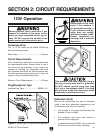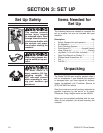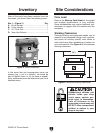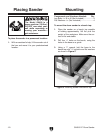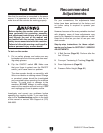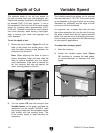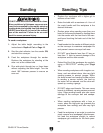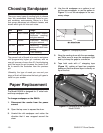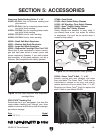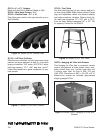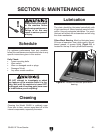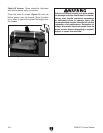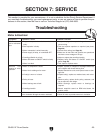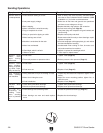
G0459 12" Drum Sander
-17-
DO NOT sand more than one board at a time.
Minor variations in thickness can cause one
board to be propelled by the rapidly spinning
sanding drum and ejected from the machine.
NEVER stand directly in front of the outfeed
area of the machine. Failure to do so could
result in severe personal injury.
To sand a workpiece:
1. Adjust the table height according to the
instructions in Depth of Cut
on Page 16.
2. Start the dust collector, turn the sander ON,
and start the conveyor.
3. Feed the workpiece through the sander.
Retrieve the workpiece by standing at the
side—not at the outfeed end.
4. Run wide stock through two or three times
without adjusting the table height. Turn the
stock 180° between passes to ensure an
even cut.
Sanding Sanding Tips
• Replace the sandpaper with a higher grit to
achieve a finer finish.
• Raise the table with a maximum of
1
⁄4 turn of
the crank handle until the workpiece is the
desired thickness
.
• Reduce snipe when sanding more than one
board of the same thickness by feeding them
into the sander with the front end of the sec
-
ond board touching the back end of the first
board.
• Feed boards into the sander at different points
on the conveyor to maximize sandpaper life
and prevent uneven conveyor belt wear.
• DO NOT sand boards less than 8" long or
less than
1
⁄8" thick to prevent damage to the
workpiece and the drum sander.
• Extend the life of the sandpaper by regularly
using a PRO-STICK
®
sanding pad (Page
19).
• When sanding workpieces with irregular sur
-
faces, such as cabinet doors, take very light
sanding passes to prevent gouges. When
the drum moves from sanding a wide surface
to sanding a narrow surface, the load on
the motor will be reduced, and the drum will
speed up, causing a gouge.
• DO NOT edge sand boards. This can cause
boards to kickback, causing serious personal
injury. Edge sanding boards also can cause
damage to the conveyor belt and sandpa
-
per.
• When sanding workpieces with a bow or
crown, place the high point up (prevents the
workpiece from rocking) and take very light
passes.
• Feed the workpiece at an angle to maximize
stock removal and sandpaper effectiveness,
but feed the workpiece straight to reduce
sandpaper grit scratches for the finish pass
-
es.



